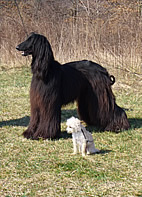Last updated: May 09, 2012
Researchers Identify Gene Involved in Dog Size

National Human Genome Research Institute
www.genome.gov
Researchers Identify Gene Involved in Dog Size
Discovery May Help Efforts to Better Understand Genetic Influences on Stature in Humans, Other Mammals
"The identification and characterization of a key genetic variant that accounts for differences in dog size is particularly exciting because the underlying gene is present in all dogs and other diverse species, including humans," said Eric Green, M.D., Ph.D., scientific director of the NHGRI Division of Intramural Research. "Discoveries like this illustrate the exciting promise of genomics research for understanding the inheritance of a wide range of traits, including those that have an impact on health and disease."
The branch of the canine family tree that includes domestic dogs diverged from that of the gray wolf more than 15,000 years ago. Due to selective breeding by humans throughout history, dogs today exhibit an extremely wide range of body types and behaviors. In fact, dogs exhibit the greatest diversity in body size of any mammalian species.
In their study, researchers explored the genetic basis for size variation among dogs by comparing the DNA of various small dog breeds, including Chihuahuas, Toy Fox Terriers and Pomeranians, to an array of larger dog breeds, including Irish Wolfhounds, Saint Bernards and Great Danes. Their investigation found that variation in one gene - IGF-1, which codes for a protein hormone called insulin-like growth factor 1 - is very strongly associated with small stature across all dog breeds studied.
"We have been intrigued by the population structure of dogs, which over the years have been selectively bred, allowing us to more readily analyze the genetic causes of particular traits than is possible in humans," said the study's senior author Elaine A. Ostrander, Ph.D., chief of NHGRI's Cancer Genetics Branch. "Nearly all of what we learn from studying body structure, behavior and disease susceptibility in dogs helps us understand some aspect of human health and biology."
In addition to Ostrander and her colleagues at NHGRI, the team included researchers from Cornell University in Ithaca, N.Y.; the University of Utah in Salt Lake City; the University of California, Los Angeles; the University of Southern California in Los Angeles; the University of Missouri in Columbia; the Waltham Centre for Pet Nutrition in Leicestershire, England; and the Nestle Research Center in St. Louis. Postdoctoral Fellow Nathan B. Sutter, Ph.D. from NHGRI's Cancer Genetics Branch, served as lead author.
"By learning how genes control body size in dogs, we are apt to learn something about how skeletal body size is genetically programmed in humans. We also will increase our data set of genes likely to play a role in diseases such as cancer, in which regulation of cell growth has been lost," said Ostrander, noting that the role of the IGF-1 gene family in prostate cancer susceptibility has already been well established.
Building upon previous research showing that the IGF-1 gene plays an important role in growth, body size and longevity in mice, the dog researchers used physical observations, X-ray imaging and DNA sequencing and genotyping analysis to study Portuguese water dogs - a breed that has an unusually wide range of skeletal size - as well as several small and large canine breeds. This analysis revealed that differences in dog body size appeared to be associated with minute genetic variations, referred to as single nucleotide polymorphisms (SNPs), in the IGF-1 gene. Researchers then narrowed the field of SNPs associated with small size by SNP genotyping in and around the IGF-1 gene in 463 Portuguese water dogs. A similar analysis was done using 526 dogs from 14 small breeds and nine giant dog breeds.
Ultimately, the researchers analyzed DNA from more than 3,000 dogs from 143 breeds to pinpoint a specific gene sequence variant, or haplotype, associated with small size in the canine genetic code. Nearly all of the small dogs studied shared this genetic variant, implicating it as a major influence on stature in dogs.
Based on their genomic analysis, the researchers also concluded that the small size trait emerged relatively early in the history of domestic dogs. They hypothesize that small size may have facilitated the rapid diversification among domestic dog breeds by making it easier for humans to maintain them in the crowded confines of developing villages and cities, as well as making them more transportable during trade and migration.
Future aims of the study are to identify genes that control other aspects of canine morphology including, for instance, leg length and skull shape. Four high-resolution photos depicting the wide size range among dog breeds are available here: Irish Wolfhound with Border Terrier; Afghan with Chihuahua Cross; Irish Wolfhound with Chihuahua Cross, Running; Irish Wolfhound with Chihuahua Cross, Standing.
The new finding follows on the completion of the dog genome sequence, announced in December 2005, research that is a part of NHGRI's Large-Scale Sequencing Research Network. The availability of the dog genome sequence allows researchers to better compare the human and dog genomes and narrow their search for genetic contributors to cancer and other major diseases.
Researchers can access the dog sequence data through the following public databases: Dog Genome Resources (www.ncbi.nlm.nih.gov/genome/guide/dog) at NIH's National Center for Biotechnology Information (NCBI); EMBL Bank (www.ebi.ac.uk/index.html) at the European Molecular Biology Laboratory's Nucleotide Sequence Database; UCSC Genome Browser (www.genome.ucsc.edu) at the University of California at Santa Cruz; and at the Broad Institute Web site (www.broad.mit.edu/mammals/dog). The SNPs may be viewed at dbSNP (www.ncbi.nlm.nih.gov/projects/SNP) at NCBI and at the Broad Institute Web site (www.broad.mit.edu/mammals/dog).
NHGRI is one of the 27 institutes and centers at the National Institutes of Health, which is an agency of the Department of Health and Human Services. The NHGRI Division of Intramural Research develops and implements technology to understand, diagnose and treat genomic and genetic diseases. Additional information about NHGRI can be found at www.genome.gov.
The National Institutes of Health - "The Nation's Medical Research Agency" - includes 27 institutes and centers, and is a component of the U.S. Department of Health and Human Services. It is the primary federal agency for conducting and supporting basic, clinical and translational medical research, and it investigates the causes, treatments, and cures for both common and rare diseases. For more, visit www.nih.gov.
Contact:
Raymond MacDougall
NHGRI
301-402-0911
macdougallr@mail.nih.gov
